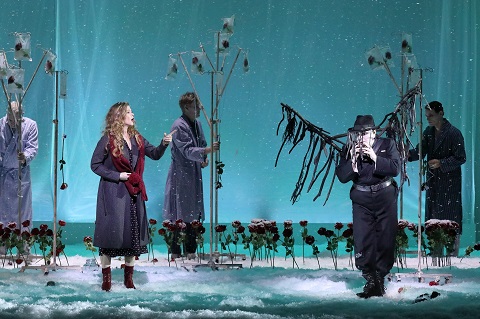Hans Abrahamsen - The Snow Queen (Munich, 2019)
Bayerische Staatsoper, 2019
Cornelius Meister, Andreas Kriegenburg, Barbara Hannigan, Rachael Wilson, Katarina Dalayman, Peter Rose, Caroline Wettergreen, Dean Power, Kevin Conners, Owen Willetts, Thomas Gräßle
Staatsoper.TV - 28 December 2019
There would appear to be two significant works in Hans Abrahamsen's recent output that have led to the creation of his first opera The Snow Queen, and they also give some advance indication of how the work would sound. One is the musical meditation on the qualities, properties, texture and character of snow, Schnee, the other is the popular success of Abrahamsen's Ophelia song-cycle Let Me Tell You, with Barbara Hannigan adding her light, agile soprano to the composer's delicate compositions and arrangements.
Those two major works are interconnected within the narrative of Hans Christian Andersen's fairy tale The Snow Queen. Like all fairy tales, there is a darker edge that lies beneath the surface which has been softened over time and narration and director Andreas Kriegenburg isn't wrong in detecting an undercurrent of what we would now recognise as mental illness in the story, one exacerbated by a sense of loss and loneliness. Unfortunately, the libretto for the work remains superficial and never delves into the depths that Abrahamsen and Kriegenburg attempt to explore in the music in the new Bavarian State Opera production of this English language version of the opera following Snedronningen's premiere in Denmark in October 2019.
Essentially the narrative of The Snow Queen involves Gerda (Barbara Hannigan) trying to rescue her brother Kay from the clutches of the Snow Queen. Their grandmother has related a story of a magic mirror created by the devil that makes beautiful things appear ugly. The mirror has shattered into thousands of pieces and shards have pierced the eye and heart of Kay, who now longer recognises the beauty in the world and has fallen into a deep depression or despair.
While still seeking to retain some of the qualities of this inner snow world that combines beauty with coldness and bleakness of winter, Kriegenburg also expresses the fairy-tale world in terms of mental illness, Kay not literally abducted by the Snow Queen, but seemingly institutionalised. His sister Gerda is not far off a state of mental instability herself. She wants to help Kay find himself and does so through a kind of dream fantasy, encountering an old woman in a garden where the nurses have faces of flowers (and later reappear as angels), as well as a Castle Crow and a Forest Crow who lead her to the Ice Palace of the Snow Queen.
In theory, Kriegenberg's approach should be a good way of making the nature of mental illness relatable at the same time as fulfilling what appears to be a Bayerische Staatsoper tradition of finding/creating seasonal works beyond the ever popular Hansel and Gretel. In reality it never seems to weave a magical spell of enchantment, and in large part it's because the libretto really never lives up to the mood or emotional undercurrents of chilly despair that is certainly there in Abrahamsen's delicate complex flurries of music. The libretto is mostly based around Gerda's repetitive search for Kay - 'Where is Kay? I have to find Kay', even though he is physically present in the not terribly original setting of a mental institution with nurses and patients taking the roles of fairy tale characters.
The libretto moreover is very wordy without ever saying anything meaningful, the English parlando never particularly musical or scanning well to fit with the musical arrangements. It does develop into a flow, and there are some beautiful passages notably around the end of Act II before the interval, with a combined trio of Gerda, the King and Queen backed by a chorus. Unable to draw any deeper meaning out of the libretto, or express it through the production design. Barbara Hannigan is of course as impressive as ever and bass Peter Rose an interesting choice for the voice of the Snow Queen, but it all comes across as very pretty and not much else.
Harald B. Thor's sets combine and highlight the disparity between the fantasy with the real-world well enough, using simple plastic sheet backdrops that have an icy appearance, with shredded plastic giving an impression of light, fluffy snow, creating an artificial winter world that also captures a sense of the austere cold world of the mind in isolation. The use of costumes also makes the narrative easy to follow who are doubles and younger versions of Gerda and Kay, but neither Hannigan's expression, Cornelius Meister's conducting nor Kriegenburg's conception are able to bring any real sense of drama to this beautiful but rather lifeless production.
Links: Bayerische Staatsoper, Staatsoper TV Opera Live



